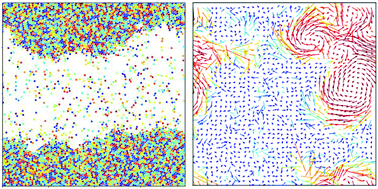Clustering and phase separation of circle swimmers dispersed in a monolayer†
Abstract
We perform Brownian dynamics simulations in two dimensions to study the collective behavior of circle swimmers, which are driven by both, an (effective) translational and rotational self-propulsion, and interact via steric repulsion. We find that active rotation generally opposes motility-induced clustering and phase separation, as demonstrated by a narrowing of the coexistence region upon increase of the propulsion angular velocity. Moreover, although the particles are intrinsically assigned to rotate counterclockwise, a novel state of clockwise vortices emerges at an optimal value of the effective propulsion torque. We propose a simple gear-like model to capture the underlying mechanism of the clockwise vortices.



 Please wait while we load your content...
Please wait while we load your content...